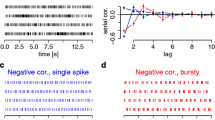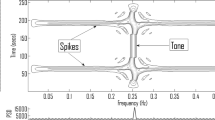Abstract
The spike interval histogram, a commonly used tool for the analysis of neuronal spike trains, is evaluated as a statistical estimator of the probability density function (pdf) ofinterspike intervals. Using a mean square error criterion, it is concluded that a Parzen convolution estimate of the pdf is superior to the conventional histogram procedure. The Parzen estimate using a Gaussian weighting function reduces the number of intervals required to achieve a given error by a factor of 5–10. The Parzen estimation procedure has been implemented in the sequential interval histogram (SQIH) procedure for analysis of non-stationary spike trains. Segments of the spike train are defined using a moving window and the pdf for each segment is estimated sequentially. The procedure which we have found most practical is interactive with the user and utlizes the theoretical results of the error analysis as guidelines for the evolution of an estimation strategy. The SQIH procedure appears useful both as a criterion for stationarity and as a means to characterize non-stationary activity.
Similar content being viewed by others
References
Bartlett, M.S.: Statistical estimation of density functions. Sankhyã A25, 245–254 (1963)
Bendat, J.S., Piersol, A.G.: Random Data: Analysis and measurement procedures. New York: John Wiley 1971
Boneva, L. I., Kendall, D., Stefanov, I.: Spline transformations: three new diagnostic aids for the statistical data-analysist. J. roy. Statist. Soc.33, 1–70 (1971)
Bryant, H. L., Marcos, A. R., Segundo, J. P.: Correlations of neuronal spike discharges produced by monosynaptic connections and by common inputs. J. Neurophysiol.36, 205–225 (1973)
Cinlar, E.: Introduction to stochastic processes. Englewood Cliffs, N.J.: Prentice-Hall 1975
Cox, D. R., Lewis, P. A. W.: The statistical analysis of series of events. London: Methuen 1965
Cox, D. R., Smith, W. L.: The superposition of several strictly periodic sequences of events. Biometrika40, 1–11 (1953)
Eckhorn, R., Pöpel, B.: A contribution to neuronal network analysis in cat lateral geniculate body: simultaneous recordings of maintained activity. Int. J. Neurosci.4, 137–142 (1972)
Fellner, W. H.: Heuristic estimation of probability densities. Biometrika61, 485–492 (1974)
French, A. S., Holden, A. V.: Alias-free sampling of neuronal spike trains. Kybernetik5, 165–171 (1971)
Gerstein, G. L., Kiang, N. Y.-S.: An approach to the quantitative analysis of electrophysiological data from single neurons. Biophys. J.1, 15–28 (1960)
Gerstein, G. L., Perkel, D. H.: Mutual temporal relationships among neuronal spike trains. Biophys. J.12, 453–473 (1972)
Good, I. J., Gaskins, R. A.: Non-parametric roughness penalties for probability densities. Biometrika58, 255–277 (1971)
Hagiwara, S.: Analysis of internal fluctuation of the sensory nerve impulse. Jap. J. Physiol.14, 234–240 (1954)
Kampé de Fériet, J., Frenkiel, F. N.: Correlations and spectra for non-stationary random functions. Math. Comp.16, 1–21 (1962)
Kawabata, N.: A non-stationary analysis of the electroencephalogram. IEEE Trans. BME-20, 444–452 (1973)
Kawabata, N.: Dynamics of the electroencephalogram during the performance of a mental task. Kybernetik15, 237–242 (1974)
Levick, W. R., Zacks, J. L.: Response of cat retinal ganglion cells to brief flashes of light. J. Physiol. (Lond.)206, 677–700 (1970)
Lewis, P. A. W. (ed.): Stochastic point processes: Statistical analysis, theory, and applications. New York: John Wiley 1972
Lindsey, J. K.: Comparison of probability distributions
Moore, G. P., Segundo, J. P., Perkel, D. H. Levitan, H.: Statistical signs of synaptic interaction in neurons. Biophys. J.10, 876–900 (1970)
Murthy, V. K.: The general point process: applications to structural fatigue, bioscience, and medical research. Reading, Mass.: Addison-Wesley 1974
Parzen, E.: On estimation of a probability density function and mode. Ann. Math. Statist.33, 1065–1076 (1962)
Perkel, D. H., Gerstein, G. L., Moore, G. P.: Neuronal spike trains and stochastic point processes: I. The single spike train. Biophys. J.7: 391–418 (1967a)
Perkel, D. H., Gerstein, G. L., Moore, G. P.: Neuronal spike trains and stochastic point processes: II. Simultaneous spike trains. Biophys. J.7, 419–440 (1967b)
Rosenblatt, M.: Remarks on some nonparametric estimates of a density function. Ann. Math. Statist.27, 832–837 (1956)
Rosenblatt, M.: A quadratic measure of deviation of two-dimensional density estimates and a test of independence. Ann. Statist.3, 1–14 (1975)
Srinivasan, S. K.: Stochastic point processes and their applications. London: Griffin 1973
Tarter, M., Kronmal, R.: On multivariate density estimates based on orthogonal expansions. Ann. Math. Statist41, 718–722 (1970)
Wahba, G.: Optimal convergence properties of variable knot, kernel, and orthogonal series methods for density estimation. Ann. Statist.3, 15–29 (1975a)
Wahba G.: Interpolating spline methods for density estimation I. Equi-spaced knots. Ann. Statist.3, 30–48 (1975b)
Wahba, G., Wold, S.: A completely automatic French curve: fitting spline functions by cross validation. Commun. Statist.4, 1–17 (1975a)
Wahba, G., Wold, S.: Periodic splines for spectral density estimation: the use of cross validation for determining the degree of smoothing. Commun. Statist.4, 125–141 (1975b)
Watson, G. S., Leadbetter, M. R.: On the estimation of the probability density. I. Ann. Math. Statist.34, 480–491 (1963)
Whittle, P.: On the smoothing of probability density functions. J. R. Statist. Soc. B20, 334–343 (1958)
Author information
Authors and Affiliations
Rights and permissions
About this article
Cite this article
Sanderson, A.C., Kobler, B. Sequential interval histogram analysis of non-stationary neuronal spike trains. Biol. Cybernetics 22, 61–71 (1976). https://doi.org/10.1007/BF00320131
Received:
Issue Date:
DOI: https://doi.org/10.1007/BF00320131




